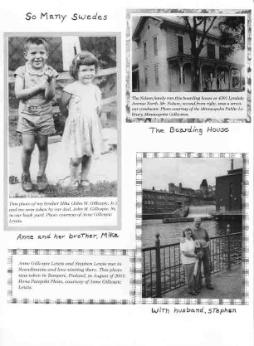 If there is one person in the Twin Cities who knows about the Swedish population living here, it is Anne Gillespie Lewis. She not only wrote a book about it, but personally had many Swedish friends and neighbors. The name of her book, So Far Away in the World, Stories from the Swedish Twin Cities, was written in 2002 and contains eight chapters of good Swedish reading. This story is taken from chapter one.
If there is one person in the Twin Cities who knows about the Swedish population living here, it is Anne Gillespie Lewis. She not only wrote a book about it, but personally had many Swedish friends and neighbors. The name of her book, So Far Away in the World, Stories from the Swedish Twin Cities, was written in 2002 and contains eight chapters of good Swedish reading. This story is taken from chapter one.
Anne related that in 1905 over 126,000 Swedes lived in Minnesota, almost one-third residing in the Twin Cities. Fifteen years later, the Swedish-born population was still the largest immigrant group in both Minneapolis and St. Paul. It can be safely said that the Twin Cities is the metropolitan area where the most Swedish-American visibility still exists.
Lewis grew up in Camden, on the far Northside of Minneapolis, close enough to the west bank of the Mississippi so that many people got bats in their houses in summer—they blamed the bats on the nearness of the river. She said that Camden was one of the many “Swede towns” that drew immigrants from Sweden. Another area was called “Swede Hollow,” on the east side of St. Paul, but the first pockets of Swedish settlements were along Washington and Cedar Aves. in Seven-Corners. From there the Swedes spread south, southwest and north, drawn to the Camden area by work. A Swedish immigrant with the unlikely name of C. A. Smith had a sawmill here that hired many immigrant workers.
The men who worked for the mill often lived in the big old boarding houses in the Camden area, one of which was run by Christine Nelson. It was a large, white frame house with a spectacular porch and was located at 4301 Lyndale Ave.
Anne goes on to say that when she was growing up, the Swedish presence was still felt in Camden. They thought it was normal that many of their friends and nearly all of the merchants in the area a few blocks away had Swedish or Norwegian names. There was John Nelson the shoe repair man, Johnson Drug on the corner of Lyndale and 42nd, Herman Johnson the tailor and his partner Berg, and Blomquist the grocer. Up on 42nd and Fremont were Carl Nelson, another grocer, Al Anderson who had the gas station, and the Falk Drugstore, later owned by another Swede, Don Carlson.
By the time she was a kid, there was no Swedish spoken on the streets, just at home by the old�-timers and their children. Salem Evangelical Lutheran Church on 42nd and Dupont was the oldest Swedish Lutheran church in Camden. The Swedes didn’t disappear—they just blended in to the American fabric. Anne said on her block, bounded by Webber Parkway, 43rd and Dupont and Emerson Aves., the roll call of Swedes or part Swedes was impressive. “We ourselves were a bit Swedish, the Elfstroms were 3/4ths and their mom, Phyllis Johnson Elfstrom was all Swedish. Up a few houses was Harry Johnson, Phyllis’ cousin, another Swede. The Storms were part Scandinavian, I think. The Leverentz family was half Swede. Ronnie Lorentzen was another Swedish-Norwegian combination, and I guess the Swedlunds were Swedish, too. Al Anderson, the gas station guy-probably was another one.”
Anne went on to tell how all the Swedish kids in her neighborhood spent their summers, and luckily enough for her, the Camden pool was right across the street from her house. “After we were done swimming, if we had a nickel we would line up at the popcorn wagon. Pete Peterson, the popcorn man, painted slogans on his old popcorn truck. The one every Camden kid remembers is, “Smile and the world smiles with you—crab and you crab alone.”
In winter, Anne told about how they skated on the Camden Park pond for hours on end. Saturday afternoon they trooped to the Camden Theater for their weekly fix of cowboys and Zorro movies. “We played outside after supper and TV was in its infancy, so the old-fashioned games were played. Some of the favorites were Pom Pom Pullaway, Red Rover, Old Lady Witch and Statues. In summer we played baseball, but I tried to stay in the outfield and hoped nobody would hit one my way.”
Going on in time, Anne tells about the Camden area being vastly changed since she grew up in the 1950s and early ‘60s. “The shopping strip on the northwest corner of the intersection of 42nd and Lyndale has been torn down and a Subway Sandwich Shop and sprawling new home of the doctor’s group she had been going to for more than 50 years—Camden Physicians—replaced the old buildings. So now, instead of going to the Camden Theater to watch cowboy movies at the Saturday matinee, I go to the same space to have my doctor check my blood pressure.” She says she imagines that all her Swedish friends and neighbors, many who live in the same neighborhood, are doing the same thing!
Note: Anne Gillespie Lewis was born in Minneapolis, grew up in the Camden Community, and studied journalism at the University of Minnesota. She worked as a sports writer for the old Minneapolis Star, then became a freelance writer. She and husband, Stephen, live in Minneapolis.
Correction: In the October Camden News the name of the Henry girls group was Ko-kettes, not Ko-kertes! We apologize for this mistake!